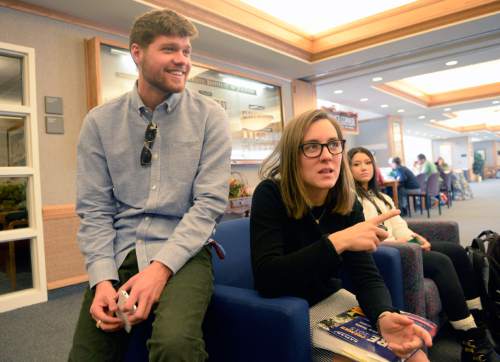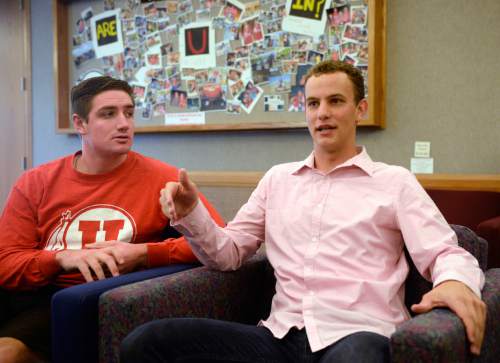This is an archived article that was published on sltrib.com in 2015, and information in the article may be outdated. It is provided only for personal research purposes and may not be reprinted.
After two years of helping Spanish speakers in New York City find faith, Brady Nelson is back in the classroom.
On a Mormon mission, "you use all your energy and time to focus on other people," Nelson said. But at the University of Utah, "it feels like everything I do is pretty selfish. My homework, my money, my classes — all that."
The logistical components of his return have been easier to navigate than the existential. The school held Nelson's scholarship during his absence. It kept tabs with his family. It is giving him course credit for his familiarity with multiple dialects spoken from Buenos Aires to Barcelona.
But the college is realizing more needs to be done.
Fewer than 2 out of 3 Mormon missionaries expected to return to the U. are back on campus this semester, administrators learned last month.
Despite quarterly newsletters and phone calls to families of the young proselytizers, U. employees failed to persuade about 120 of the anticipated 270 returning students to enroll this fall, a success rate of about 55 percent, suggest early data from the school.
"We know we have to do more," said Mary Parker, associate vice president of student affairs.
Parker shared the insight with the U.'s board of trustees' October meeting.
The estimates from the state's flagship school cover any student who left for "religious service," but it provides a glimpse into the potential academic impact of a historic policy change by The Church of Jesus Christ of Latter-day Saints, which dropped its minimum missionary ages in fall 2012. For men, the age fell from 19 to 18 and, for women, 21 to 19.
The difference is only a year or two, but it has resulted in a surge of 26,000-plus additional missionaries around the globe.
"If you're 19 or 20, people are like, 'Why are you still here?' " said Nelson, who returned in June. A freshman at the time of the announcement, he decided to finish the school year before accepting his faith's call so he could hold on to the grant covering his tuition.
Not all of Utah's public colleges have released data like the U.'s. But early enrollment numbers show that more students are on state campuses this semester, and spikes in certain age groups indicate returning Mormon missionaries are largely responsible for the boost. Men on campus who left as early as possible for their two years away come back at age 20 — a category that shot up by 35 percent, from 4,800 in 2012 to 7,500. Women return at age 20 or 21 — a group that swelled 10 percent in the same time frame, from roughly 9,200 to 10,200.
Orem's Utah Valley University surpassed the U. as the state's biggest school, with a 6 percent surge in enrollment. It now has about 33,200 full- and part-time students, compared with the U.'s 31,600.
Southern Utah University's student body in Cedar City ballooned by 16 percent. Administrators credit better advising and more dogged recruitment, not the religious exodus, for the rise.
But the U.'s enrollment was virtually flat, edging up just half a percent.
Most of the now-absent "sisters" and "elders" on Mormon missions chose to work after recently touching down in Salt Lake City, said U. spokeswoman Maria O'Mara, adding that the majority of that lot say they intend to someday earn a U. degree.
"The economy is hot," explained U. President David Pershing. Sunnier job prospects likely spurred more would-be students, not just missionaries, to work full time instead of study.
Still, other returned missionaries expected back to the U. are enrolled in college, but not in Salt Lake City. Several are 40 miles south in Provo at LDS Church-owned Brigham Young University. Some went to that private school's Hawaii or Idaho campuses, O'Mara said.
Mission presidents, for their part, counsel the young proselytizers on long-term goals, often touching on education. But they are not explicitly required to bring up the subject of college.
"Missionaries are encouraged to plan their future," LDS Church spokesman Eric Hawkins said in a statement, "taking into consideration such things as education, work, dating and service in the church."
They also "are given time, as necessary, to complete applications," he continued.
The historic missionary exodus in recent years has included thousands of young women.
Of the students who were expected to return to the U. after choosing to defer their studies to serve a mission, 16 were women, O'Mara said. And just a handful are enrolled. But Pershing said he is eager to ensure women, not just men, return to campus.
"We need the right support systems," Pershing said, including more resources for women, who he believes may be more likely to get married after returning from LDS missions.
To that end, more day care, lactation stations and online course offerings are needed, Pershing said. The U. is working on all of these, he added, but has not imposed any deadline.
Debra Daniels, the director of the U.'s Women's Resource Center, told the trustees the resources were paramount to keeping women on track to earn degrees and urged them to consider what's missing from campus.
"How many spaces do we really have that are conducive to parents with families?"
Nelson said he believes men and women tend to return to campus as soon as they can — so long as finances and family allow.
"They've been taught for two years to stay busy and productive," he said. "A lot of times they just go crazy if they don't have something to do."
Twitter: @anniebknox







